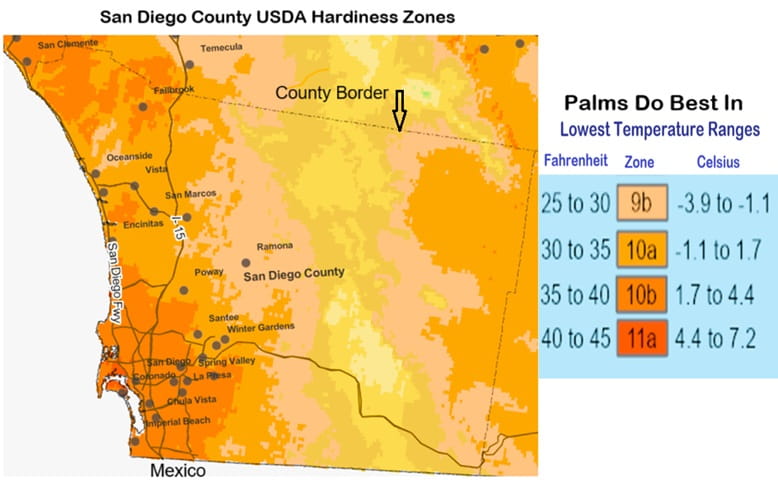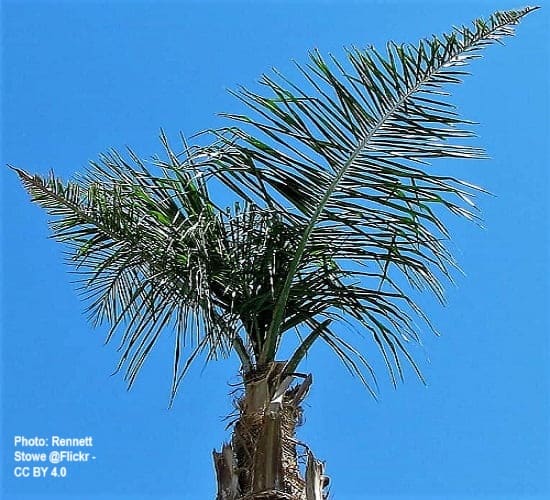- Home
- Palm Tree Problems
- Palm Habitat Ills
Palm Tree Habitat
Natural Environments & Their Problems
A Palm Tree Habitat would include the needed climate for palm trees. In many places around the world palms are iconic. Anyone thinking of palms, or a palmy habitat, pictures a place in the tropics. With palms along sandy beaches, nearby to azure seas, and flowing fronds in warm fragrant breezes.
Most palm trees originated in warm, humid climates. Like those in the above palm tree habitat description.
- They're mostly found in totally tropical settings. Many grow in subtropical climates. Some even survive in temperate zones!
- Some palms like very wet areas, either growing right in swampy land, or up out of it in near a lake or river. In soils with organic matter.
- Others need dryer climates, with excellent sandy-type soil drainage.
Many palm trees are quite hardy, even surviving to 100+ years old. Their natural habitat needs can be restricted by problems that they face in their habitats. These troubles can affect their healthy life. Lately there are a few more issues to consider.
Check out these issues that are concerning in palm tree habitats:
- Physiological Problems From Weather, such as hurricanes, cyclones & typhoons.
- We've sadly seen some of this: Human interference.
- Climate Change & its effects.
- Attacks from a Different Sort of Palm World.
We'll go into all these issues & more! For palms to keep on keeping on. 😊
At Mission: Palm Trees
Palm lovers can soothe their palm-related searches and concerns. Our articles are intended to inform, while having fun, easily Finding What You Want or Need. Without unneeded shoptalk & tiring endless research. We Research For You!
Physiological Palm Tree Problems
What's meant by physiological palm problems?
Conditions harmful to palms not caused by germs, fungai, insects, etc. They're often environmental. Some are preventable.
Especially if you use Advance Landscape Plans when planting a palm for yourself. Or if you're planning on Purchasing a Palm to keep indoors for potting.
How Do Palm Trees Survive Hurricanes?
Palms will usually face various weather-related problems, because of their natural palm tree habitat.
Hurricanes (typhoons in the Northwest Pacific & cyclones in the South Pacific & Indian Ocean) may cause damage to palm trees. Terrific storms like these uproot trees & strip off leaves. If trunks are harmed during a hurricane, it opens the possibility of disease & harm from pests.
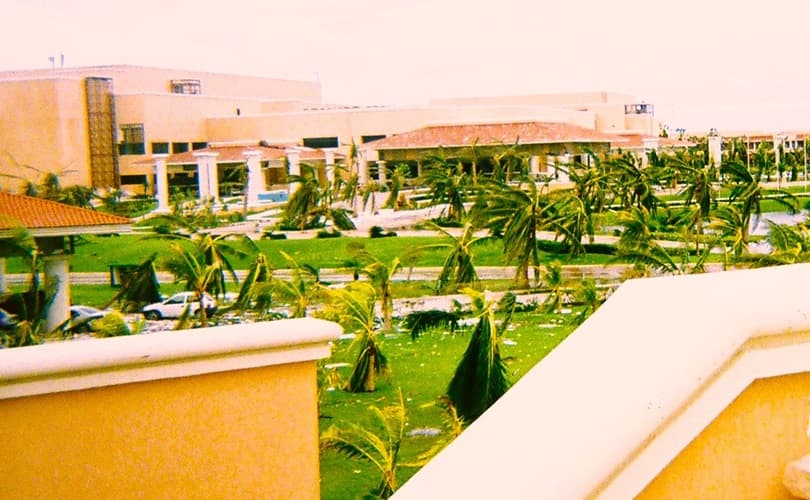 Palms Trashed at a Cancun Resort After 3 Days of Hurricane Wilma - It Was an Experience!
Palms Trashed at a Cancun Resort After 3 Days of Hurricane Wilma - It Was an Experience!Although, most palms are able to survive hurricane speed winds. The Growth of the Stems & Trunk are Constructed Differently from all other trees. It's like they're reinforced with a flexible rebar!
So most will bend with the wind. Maybe only losing some fronds. This physiological problem palms have solved for themselves!
How People Harm a Palm Tree Habitat
Of course people play a role in most pollution. But there are other events or circumstances which have people involved in harming palms and causing habitat loss. Some carelessly, some intentionally & some inadvertently.
Air & Water Pollution in Palm Habitats
Air & water pollution are concerns in palm tree habitats.
Even though palm fronds absorb CO2, air pollution containing toxins & chemicals can affect palm growth & survival. Just like with us, it's not healthy for them!
Water with contaminants can harm palms in two ways: the water itself & harm to soil.
- Water pollution can have substances that dismantle nutrient uptake.
- Agricultural irrigation runoff & industrial waste-water soaks into the soil, causing contamination. Soil contains palm tree nutrition needs. But when it's unbalanced with poisonous or excessive chemicals, palms will suffer.
- Other toxic substances! Like when a poisonous substance is sprayed upwind. Like weed killer, etc., which palms can absorb.
Recent Article
-
San Diego palm trees: History, Species, and Their SoCal Charm
Fascinated by San Diego palm trees? Discover their history, types, and why they're a staple of SoCal’s SD neighborhood scenery to inspire your landscape design.
Palm Tree Habitat Loss from Commercial Enterprises
Human activities can threat palm tree habitats. Providing housing in some areas means land is cleared. Many palms could be destroyed in habitats where they naturally grow, for instance Florida. Some aren't transplanted easily, if commercial enterprises even bothers to try.
Palm trees have many business-related uses. Which can assist a country's economy. But when a commercial enterprise ignores best practices, massive deforestation & habitat destruction occurs.
For example, Elaeis guineensis (African Oil Palm) is grown for palm oil production. It's lately brought in great controversy for methods used. Plantations growing these non-native palms can disrupt local ecosystems. They compete with native palms for resources & can overtake an area.
Attacks by Palm Tree Non-lovers (Haters! 🫤)
Nutrition from photosynthesis is essential in palm tree habitats. When tree workers don't understand essentials for palm environments, it can happen.
Like when palms aren't Pruned Correctly.
SOCIAL MEDIA
I saw a post in social media with a person who lived near All the Los Angeles Palms saying "I hate palm trees." Larger cities have planted many palms for their tropical esthetic value. Now they've begun rethinking growing more. Even getting rid of some & instead planting woodland type trees.
TRUE STORY
A friend of ours told us of a palm in her Tucson yard that was attacked by vandals. And what happened afterward.
We covered these premium newsy stories for those Subscribers to our Life Amid the Palms monthly memo. You'll have access to that exclusive content by entering your info here:
How Climate Change Affects Palm Trees
Over time in recent years, significant weather events have been happening from climate change effects. We've already mentioned one: those increasingly dangerous hurricanes. Which stress palms and increase rainfall. But there are other events influenced by ongoing climate change.
Most Palms Suffer With Drought Conditions
Drought is another weather stressor for palm trees. Yes, some species are drought-tolerant, but their survival still requires a regular watering schedule.
Excessively lengthy dry periods get many palm species to feeling water stress. Fronds can wilt & trunks will adjust by narrowing their cell width.
Heatwaves Add to the Threat in Palm Environments
The rise of average global temperatures threaten palm tree habitats. There has been increasing frequency & intensity of heatwaves, along with drought.
Some palm species can get dehydrated. They'll feel that heat stress. Extra warmth from climate change can create pest infestations that palms hadn't faced before. As insects adjust their natural locations.
It's knowing a palm's needs that's best for avoiding or modifying drought situations. Like these possibilities:
- Most Palms Need Full Sun
NO MORE EXCESSIVE SUN!
- But some are Palms that shouldn't get continual sun. Their Native Growth is in a forest's understory. Like within rainforest soils.
- Those types of palms could be dangerously sunburned!
 Sooo Sunny! Can the Palm take it??
Sooo Sunny! Can the Palm take it?? Shady Areas of a Forest - Palm Tree Habitat for Shade Lovers!
Shady Areas of a Forest - Palm Tree Habitat for Shade Lovers!New Rainfall Conditions May Overwater Palms
Changing rainfall patterns can create unfavorable conditions for palms. Excess rainfall & flooding could make for waterlogged soil. Too much pooling water can suffocate roots or lead to root rot.
Sea-levels are rising. A particular concern for palm trees in coastal areas. Waters begin overtaking seaside parks with palms. This Really Happened near Santa Barbara California.
Those that don't fall over can still be affected by the ocean's saltwater soaking into more inland soils. Most palm species cannot tolerate these salty conditions. In these unique coastal ecosystems, populations of palms will have an early death.
BAD WEATHER, like flooding or drought. Giving palms too little water and/or more seering sun than it likes. Or with too much rainfall, keeping palm roots soggy.

Freezing Weather & More is Bad in Palm Tree Habitats
Frosty freezing weather often causes Cold Damage on Palms.
Tropical palm plants need protection from extreme cold weather. Especially when they're young. By [ad link] Choosing the Best Plant Cover for the palm you're protecting.
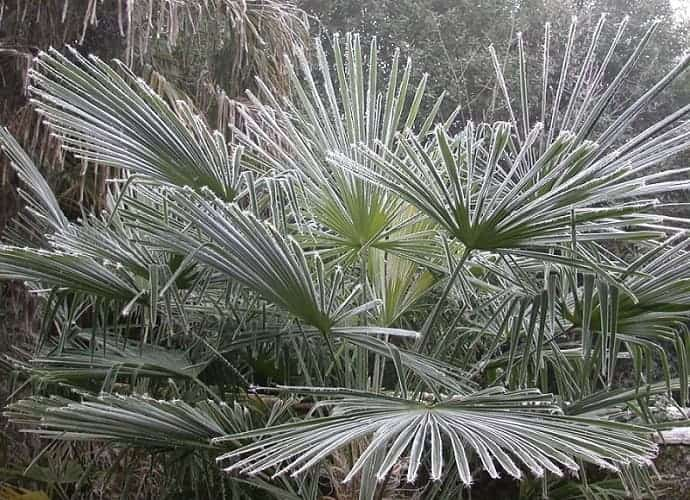 Frosty the Fan Palm! Is that a contradiction in lifestyle?
Frosty the Fan Palm! Is that a contradiction in lifestyle?Are These Issues Palm Tree Habitat Problems?
Have you heard rumors about palms? They're poisonous or their roots look strange. Is this true or normal?
Are There Toxic Palm Trees in Some Habitats?
Some palms have irritating parts.
For instance the Clustering Fishtail Palm (Caryota mitis) is unique looking, nice as a hedge palm & pretty easily grown. Yet when it starts fruiting don't run to grab some. This toxic palm is very irritating to skin.
Other palms with similar toxic areas exist. But not deadly unless you have a severe allergic reaction to toxic palm sap, like anaphylaxis. Always check a Palm Tree Guide if this is a worry.
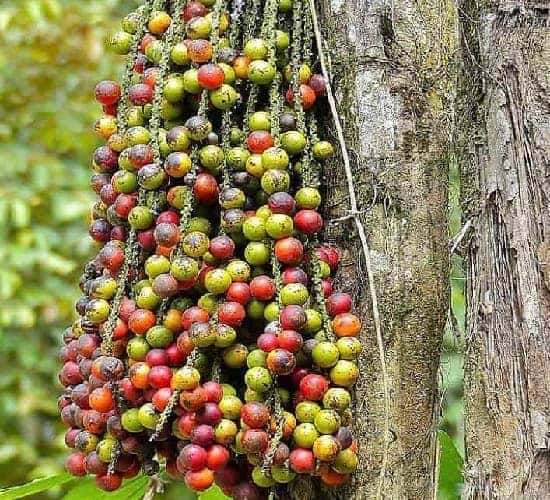 Fruits of the Caryota mitis (Fishtail Palm) are Ripening
Fruits of the Caryota mitis (Fishtail Palm) are RipeningPhoto: Bernard Dupont - CC BY-SA 4.0
Are Palm Trees Dangerous for Cats in the Home Habitat?
Rumor has it that a Parlor Palm is a Toxic Palm for Cats. It's not totally true. That talk began because of the fruit. It's a skin irritant for humans. And can cause problems for cats or dogs.
Yes, there are Plants That are Toxic to Cats. You'll want to avoid them if you're a pet lover.
One prevention is by not allowing it to get to the fruiting stage. Trim away the flower branch (inflorescence) when flowering is finished.
 Pet Cat VS. a Parlor Palm!
Pet Cat VS. a Parlor Palm!Are Above Ground Roots Normal in Palms?
Some palms suddenly start to show strange types of roots. They're above the ground, towards the bottom of the palm trunk. Did you think that might be a Palm Tree Problem? If so, don't worry! Some Species Have Normal Roots growing above-ground.
Takeaways for palm tree Habitat - Natural Environments
& Their Problems
We've seen many ways that palm tree habitats are under threat. Including climate's weather extremes, pollution & human interference activities.
Some are hard at work to address these challenges. They consider many approaches.
But it takes the will & cooperation of many to solve climate change, use sustainable land practices, & consider palms as a quality-of-life issue.
As iconic symbols of tropical & subtropical regions, palm tree habitat preservation is important for this unique plant in its wonderful habitats. That's why we Support the International Palm Society. We hope you will, too.
